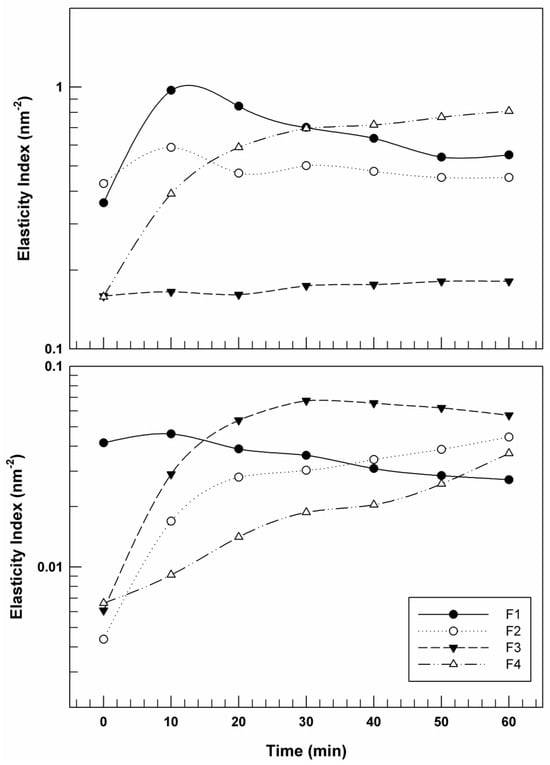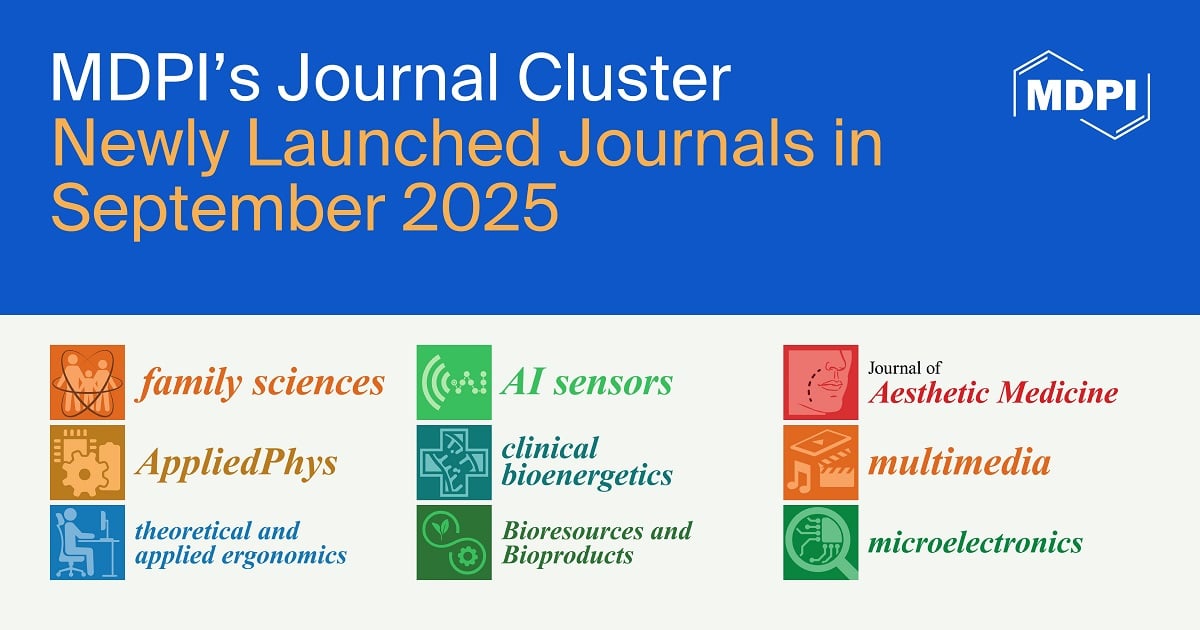Journal Description
Cosmetics
Cosmetics
is an international, scientific, peer-reviewed, open access journal on the science and technology of cosmetics published bimonthly online by MDPI.
- Open Access— free for readers, with article processing charges (APC) paid by authors or their institutions.
- High Visibility: indexed within Scopus, ESCI (Web of Science), CAPlus / SciFinder, and other databases.
- Journal Rank: JCR - Q1 (Dermatology) / CiteScore - Q1 (Surgery)
- Rapid Publication: manuscripts are peer-reviewed and a first decision is provided to authors approximately 22.5 days after submission; acceptance to publication is undertaken in 3.9 days (median values for papers published in this journal in the first half of 2025).
- Recognition of Reviewers: reviewers who provide timely, thorough peer-review reports receive vouchers entitling them to a discount on the APC of their next publication in any MDPI journal, in appreciation of the work done.
Impact Factor:
3.2 (2024);
5-Year Impact Factor:
3.9 (2024)
Latest Articles
Cosmetics for Sensitive Skin: Assessing Rheological Properties, Stability, and Safety
Cosmetics 2025, 12(6), 239; https://doi.org/10.3390/cosmetics12060239 (registering DOI) - 27 Oct 2025
Abstract
Skin compatibility is a common issue and can often be worsened by certain ingredients in cosmetics. This is why developing well-balanced and -tolerated formulas is now an essential challenge. In this work we developed a cream rich in antioxidant, soothing, and moisturizing agents
[...] Read more.
Skin compatibility is a common issue and can often be worsened by certain ingredients in cosmetics. This is why developing well-balanced and -tolerated formulas is now an essential challenge. In this work we developed a cream rich in antioxidant, soothing, and moisturizing agents complying with concentration limits for sensitive skin. An initial optimization was carried out, and the best-performing formula was fully characterized to test its rheological properties under static or dynamic conditions and product safety. The formulation proved to be highly stable even under thermal stress, as shown by Turbiscan Lab analyses, which reported backscattering values ±2. Rheological tests also indicated a solid-like behavior with reduced viscosity at skin temperature of 32 °C, confirming the good spreadability of the cream. Finally, in vivo tests on healthy volunteers showed excellent safety results and good overall appreciation of the product. No changes in transepidermal water loss (7.9 ± 3.5 vs. 5.5 ± 0.4, p > 0.05), skin hydration (44.2 ± 18.6 vs. 50.5 ± 14.1, p > 0.05), or color were detected within 6 h from application, compared with baseline values. Moreover, volunteers highlighted the cream’s suitability for dry skin and expressed satisfaction with spreadability, a nourishing and hydrating sensation after application, and the absence of residues, consistently rating them ≥4 in the skin feeling questionnaire. These results are promising and support the potential use of the product on sensitive skin.
Full article
(This article belongs to the Section Cosmetic Dermatology)
►
Show Figures
Open AccessArticle
Phyto-Assisted Synthesis and Investigation of Zinc Oxide Nanoparticles for Their Anti-Aging, Sun Protection and Antibacterial Activity
by
Harshad S. Kapare, Mayuri Bhosale, Pawan Karwa, Deepak Kulkarni, Ritesh Bhole and Sonali Labhade
Cosmetics 2025, 12(6), 238; https://doi.org/10.3390/cosmetics12060238 (registering DOI) - 24 Oct 2025
Abstract
Objective: This study aimed to develop eco-friendly zinc oxide nanoparticles (ZnO NPs) using Punica granatum (pomegranate) peel extract and to evaluate their antioxidant, antimicrobial, and photoprotective potential. Method: ZnO NPs were synthesized via a green chemistry route employing polyphenol- and flavonoid-rich peel extract
[...] Read more.
Objective: This study aimed to develop eco-friendly zinc oxide nanoparticles (ZnO NPs) using Punica granatum (pomegranate) peel extract and to evaluate their antioxidant, antimicrobial, and photoprotective potential. Method: ZnO NPs were synthesized via a green chemistry route employing polyphenol- and flavonoid-rich peel extract as reducing and stabilizing agents. The nanoparticles were characterized using FTIR, SEM, XRD, DSC, DLS, and UV–Vis spectroscopy. Biological activities were assessed through in vitro assays including antioxidant (DPPH), anti-collagenase, anti-elastase, anti-tyrosinase, antimicrobial activity, and SPF determination. In vivo photoprotective efficacy was further evaluated in UVB-irradiated rat models, with histological analysis to confirm structural skin changes. Results: The optimized ZnO NPs exhibited an average particle size of ~194 nm with a zeta potential of −18.2 mV, indicating good stability. They demonstrated notable antioxidant activity (DPPH IC50 = 52.91 µg/mL), substantial tyrosinase inhibition (72% at 200 µg/mL), and antibacterial activity with inhibition zones up to 19 mm against S. aureus and 17 mm against E. coli. The nanoparticles also showed excellent UV absorption, with an SPF value of 29.8, exceeding the FDA threshold for effective sun protection. In vivo, topical application of ZnO NPs in UVB-exposed rats led to a 69% reduction in epidermal thickness and preservation of collagen fibers compared with UV controls. Conclusions: These findings confirm that P. granatum peel extract–mediated ZnO NPs possess significant antioxidant, antimicrobial, and photoprotective activities.
Full article
(This article belongs to the Section Cosmetic Formulations)
►▼
Show Figures
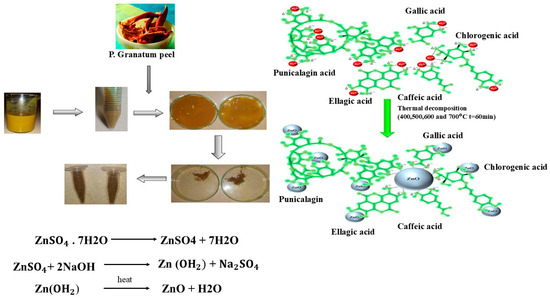
Figure 1
Open AccessArticle
Persicaria tinctoria Extract Mitigates UV-Associated DNA Damage and Inflammation, While Boosting Vitamin D3 and Melanin in Human Skin
by
Morgane de Tollenaere, Catherine Zanchetta, Anaïs Durduret, Jessy Martinez, Bénédicte Sennelier-Portet, Jean Tiguemounine, Amandine Scandolera and Romain Reynaud
Cosmetics 2025, 12(6), 237; https://doi.org/10.3390/cosmetics12060237 - 23 Oct 2025
Abstract
Benefit/risk management of skin exposure to sunlight, especially ultraviolet (UV) rays, is mainly driven by photoaging, cancer incidence, and the requirement for vitamin D3 synthesis. Antioxidant phytocompounds are considered to be a valuable source of molecules to protect skin from UV-induced damage, but
[...] Read more.
Benefit/risk management of skin exposure to sunlight, especially ultraviolet (UV) rays, is mainly driven by photoaging, cancer incidence, and the requirement for vitamin D3 synthesis. Antioxidant phytocompounds are considered to be a valuable source of molecules to protect skin from UV-induced damage, but their impact on other UV-related metabolic pathways is rarely described. In this study, an indigoid-rich Persicaria tinctoria extract (PTE) was evaluated on three consequences of UV exposure: DNA damage and inflammation, vitamin D3 content, and melanogenesis. A moderate UV exposure was applied on skin models, corresponding to approximately 1 h exposure in the spring in western Europe. UV-induced DNA damage and inflammation were measured through the quantification of cyclobutane pyrimidine dimers (CPDs) and cytokines. Response to heat stress was quantified through the release of prostaglandin. Then, the impact of PTE on vitamin D3 and melanin synthesis was observed. PTE decreased by −56% in the number of cells presenting CPDs. PTE decreased the production of pro-inflammatory cytokine IL-6 (−59%) and stimulated the release of the protective cytokine IL-1Ra (+49%). It decreased PGE2 release by −27%. In skin explants, PTE boosted the vitamin D3 concentration (+345%). Several genes involved in melanogenesis were up-regulated by PTE (MC1R × 2.46, MITF × 1.69, TYR × 2.06, MLPH × 1.53). It promoted melanin content by +126% and by +86% when associated with SPF 30. The extract decreased the amount of protective eumelanin, leading to visible skin tanning of reconstructed human epidermis (L*-15%, ITA −125%). As a new finding, PTE minimized DNA damage and inflammation caused by a daily dose of UV, and surprisingly, promoted vitamin D3 and eumelanin synthesis, suggesting that it represents an opportunity to reconcile skin protection and the physiological need for sunlight.
Full article
(This article belongs to the Section Cosmetic Dermatology)
►▼
Show Figures

Graphical abstract
Open AccessReview
Evaluation, Symptoms, Influencing Factors, and Prospects of Sensitive Scalp: A Literature Review
by
Xiaoxi Yan, Qian Jiao, Congfen He, Yan Jia, Huaming He and Cheng Zhou
Cosmetics 2025, 12(6), 236; https://doi.org/10.3390/cosmetics12060236 - 22 Oct 2025
Abstract
Sensitive scalp (SSC) is a common but often overlooked dermatological state, characterized by subjective symptoms such as pruritus, tingling, tightness, pain, or burning sensations. Primary SSC typically occurs in the absence of visible clinical inflammation. Numerous studies have suggested that the onset of
[...] Read more.
Sensitive scalp (SSC) is a common but often overlooked dermatological state, characterized by subjective symptoms such as pruritus, tingling, tightness, pain, or burning sensations. Primary SSC typically occurs in the absence of visible clinical inflammation. Numerous studies have suggested that the onset of SSC may be influenced by a variety of intrinsic and extrinsic factors, including physical (ultraviolet radiation, changes in temperature and humidity), chemical (cosmetic ingredients, environmental pollutants), and psychological factors (emotional stress). This article provides a narrative review of the current research on SSC, drawing on literature published between 1963 and 2024 in PubMed, Elsevier, and Web of Science databases. We summarize its hallmark symptoms, available evaluation methods, potential mechanisms, and contributing factors and propose corresponding scalp care recommendations. This review aims to offer theoretical insights into the pathogenesis of SSC and to support the development of effective protective strategies.
Full article
(This article belongs to the Section Cosmetic Dermatology)
►▼
Show Figures

Figure 1
Open AccessArticle
Efficacy and Safety of a Novel Anhydrous 0.1% Retinal-Based Concentrate with Hydrophilic Actives for Photoaged Skin: A Six-Week Prospective Study
by
Ulf Åkerström, Chloé Gaudicheau, Blandine Locret and Johanna Maria Gillbro
Cosmetics 2025, 12(6), 235; https://doi.org/10.3390/cosmetics12060235 - 22 Oct 2025
Abstract
Background: Skin aging is influenced by intrinsic factors such as genetics and cellular decline, and extrinsic factors including UV exposure, pollution, and lifestyle. Cosmetic or over-the-counter retinoids, particularly retinal (retinaldehyde), have shown strong efficacy in reducing photoaging signs—such as fine lines, wrinkles, and
[...] Read more.
Background: Skin aging is influenced by intrinsic factors such as genetics and cellular decline, and extrinsic factors including UV exposure, pollution, and lifestyle. Cosmetic or over-the-counter retinoids, particularly retinal (retinaldehyde), have shown strong efficacy in reducing photoaging signs—such as fine lines, wrinkles, and pigmentation—while offering improved tolerability compared to prescription-based retinoids like all-trans retinoic acid. However, their instability in formulations and limited bioavailability when applied topically remain major challenges. Objective: This exploratory study aimed to assess the efficacy and safety of a novel mix-activated anhydrous 0.1% retinal concentrate formulated also with hydrophilic active ingredients—N-acetyl glucosamine, niacinamide, ascorbic acid, and alpha-glucan oligosaccharide—in improving signs of skin aging over six weeks. Methods: A prospective, single-center study was conducted with 27 healthy adults (24 female and 3 male, aged 40–69 years, 21 with skin phototype III and 6 with phototype II) exhibiting visible signs of photoaging. Participants applied the retinal concentrate once daily, mixed in a 1:2 ratio with a moisturizer before application. Objective skin parameters, including pigmentation, fine lines, wrinkles, texture, volume, and pore visibility, were assessed using the Antera 3D imaging system at baseline and after six weeks. A self-evaluation questionnaire was completed at week six. Statistical significance was determined using the Wilcoxon signed-rank test (p < 0.05) and was corrected for multiple analyses. Results: Significant improvements were observed across all parameters: pigmentation (−12%, p < 0.0001), fine lines (−14%, p < 0.0001), wrinkle depth (−5%, p = 0.0045), skin texture (+12%, p < 0.0001), volume irregularities (−15%, p < 0.0001), and pore visibility (−24%, p < 0.0001). No significant change in redness was detected (p = 0.6664), indicating a good tolerability to the test product. Self-assessments reflected high user satisfaction: 81% reported improved skin appearance, 43% noted reduced need for makeup use, and 40% observed visible improvements already within two weeks. Conclusions: The anhydrous 0.1% retinal concentrate with hydrophilic actives significantly improved clinical signs of photoaging without causing irritation. The innovative mix-activated formulation stabilizes sensitive ingredients and enhances their efficacy, offering a novel, active, and well-tolerated approach to anti-aging skincare.
Full article
(This article belongs to the Section Cosmetic Dermatology)
►▼
Show Figures

Figure 1
Open AccessCommunication
Glutathione Trisulphide Improves Skin Brightness with Anti-Melanogenesis Effects and Maintains Intracellular Persulphide Levels
by
Yoshiaki Uchida and Toshiya Sato
Cosmetics 2025, 12(5), 234; https://doi.org/10.3390/cosmetics12050234 - 21 Oct 2025
Abstract
Melanin, the principal component of skin pigmentation, is produced through tyrosinase activity. Recently, supersulphides have been identified in human cells and found to play a role in maintaining cellular activities. Glutathione trisulphide (GSSSG), a supersulphide with antioxidant properties, has various biological effects. However,
[...] Read more.
Melanin, the principal component of skin pigmentation, is produced through tyrosinase activity. Recently, supersulphides have been identified in human cells and found to play a role in maintaining cellular activities. Glutathione trisulphide (GSSSG), a supersulphide with antioxidant properties, has various biological effects. However, the influence of melanin production on intracellular persulphide levels remains unclear, and no studies have reported the anti-melanogenic effects of GSSSG. Therefore, we aimed to elucidate the impact of melanogenesis on intracellular persulphide abundance and synthesis, as well as the efficacy of GSSSG in inhibiting melanogenesis in melanoma cells. In this study, B16-F0 cells were used to evaluate the melanin and intracellular persulphide levels by alpha-melanocyte-stimulating hormone (α-MSH). Moreover, the effects of GSSSG on melanin production were studied. The results revealed that α-MSH-induced melanogenesis significantly increased melanin production and decreased intracellular persulphide levels. Furthermore, the expression of persulphide synthesis genes, including Cars2 and Cbs, was significantly downregulated by α-MSH. In contrast, GSSSG significantly suppressed α-MSH-induced melanin production. Notably, GSSSG restored the intracellular persulphide levels reduced by α-MSH and upregulated Cars2 and Cbs expression. These findings suggest that GSSSG exerts anti-melanogenesis effects, maintains intracellular persulphide levels, and improves skin brightness.
Full article
(This article belongs to the Section Cosmetic Dermatology)
►▼
Show Figures

Figure 1
Open AccessCorrection
Correction: Kim et al. An Adhesive Peptide Derived from Mussel Protein Alleviates LL37-Induced Rosacea Through Anti-Inflammatory and Anti-Angiogenic Mechanisms. Cosmetics 2025, 12, 143
by
Tae Yoon Kim, Jin Hyeop Kim, Yeon-Jun Lee, Min Ji Song, Ha Hui Park and Ji Hyung Chung
Cosmetics 2025, 12(5), 233; https://doi.org/10.3390/cosmetics12050233 - 21 Oct 2025
Abstract
In the original publication [...]
Full article
(This article belongs to the Section Cosmetic Dermatology)
Open AccessArticle
Selective Regulatory Effects of Lactobacillus Plantarum Fermented Milk: Enhancing the Growth of Staphylococcus Epidermidis and Inhibiting Staphylococcus aureus and Escherichia coli
by
Yajuan Sun, Ying Wang, Zixia Ren, Shasha Wang, Yun Ding, Nan Liu, Cheng Yang and Bingtian Zhao
Cosmetics 2025, 12(5), 232; https://doi.org/10.3390/cosmetics12050232 - 17 Oct 2025
Abstract
To address the limitation of traditional broad-spectrum antimicrobial agents in compromising skin microbiota homeostasis, this study developed Lactobacillus plantarum fermented milk (FM) as an innovative strategy for selectively regulating microbial communities to restore skin microbiota balance. FM was produced through protease hydrolysis in
[...] Read more.
To address the limitation of traditional broad-spectrum antimicrobial agents in compromising skin microbiota homeostasis, this study developed Lactobacillus plantarum fermented milk (FM) as an innovative strategy for selectively regulating microbial communities to restore skin microbiota balance. FM was produced through protease hydrolysis in combination with L. plantarum fermentation. Selective antibacterial properties were evaluated via monoculture experiments (Escherichia coli, Staphylococcus aureus, and Staphylococcus epidermidis) and pathogen–commensal co-culture systems. It was found that FM can selectively inhibit pathogens (E. coli and S. aureus) and promote the growth of commensal bacteria (S. epidermidis) in monoculture, and can reduce the growth and competitiveness of E. coli and S. aureus while relatively increasing the colony count of S. epidermidis in the co-culture system. Metabolomic profiling was further performed to identify metabolic alterations induced by FM. It was found that FM can activate the pyruvate metabolic node, significantly enhancing the metabolic fluxes of lactic acid, citric acid, and short-chain fatty acids, which triggered the acid stress response of pathogenic bacteria while consuming a considerable amount of energy, attenuating their reproductive capacity without impacting the growth of commensal bacteria. Overall, FM showed selective antimicrobial activity against pathogens (E. coli, and S. aureus) and preservation of commensal S. epidermidis, offering a foundational reference for the development of postbiotics aimed at maintaining cutaneous microbial homeostasis.
Full article
(This article belongs to the Special Issue Functional Molecules as Novel Cosmetic Ingredients)
►▼
Show Figures

Graphical abstract
Open AccessArticle
Anti-Inflammatory and Antioxidant Properties of Anti-UV Creams Enriched with Natural Extracts from Avocado, Apple, and Kiwi By-Products, with and Without Nanobubbles
by
Olga I. Tsiapali, Nefeli-Ioanna Kontaxi, Konstantinos Pavlidis, Anna Ofrydopoulou, Vasileios Prokopiou, Sophia Letsiou, Ramonna I. Kosheleva, Athanassios Mitropoulos and Alexandros Tsoupras
Cosmetics 2025, 12(5), 231; https://doi.org/10.3390/cosmetics12050231 - 16 Oct 2025
Abstract
This study investigates the development and evaluation of anti-photoaging creams enriched with natural extracts from avocado, apple, and kiwi by-products, with and without nanobubbles (NBs), focusing on their antioxidant, photoprotective, anti-inflammatory, and antiplatelet properties. Extract-containing creams showed significantly higher antioxidant capacity, particularly in
[...] Read more.
This study investigates the development and evaluation of anti-photoaging creams enriched with natural extracts from avocado, apple, and kiwi by-products, with and without nanobubbles (NBs), focusing on their antioxidant, photoprotective, anti-inflammatory, and antiplatelet properties. Extract-containing creams showed significantly higher antioxidant capacity, particularly in the ferric reducing antioxidant power (FRAP) assay (S: 710.4 ± 344.3, NB: 566.3 ± 185.0, X: 202.8 ± 145.6 μmol TE/g DW at production; S: 631.7 ± 277.8, NB: 1019.3 ± 574.0, X: 449.8 ± 43.9 μmol TE/g DW after 1 month; p < 0.05), indicating up to a 250% improvement compared to the base cream and stable antioxidant activity during storage. The sun protection factor (SPF) increased in extract-containing creams after storage (8.7 ± 0.8 → 9.5 ± 0.6; p < 0.05). Attenuated total reflectance Fourier-transform infrared spectroscopy (ATR-FTIR) with Strat-M® membranes revealed enhanced penetration of active compounds in enriched creams, while NBs did not significantly change absorption profiles. Platelet aggregation assays showed markedly lower half maximal inhibitory concentration (IC50) values in extract-enriched creams compared to the base cream for both the platelet-activating factor (PAF) pathway (S: 300.0 ± 42.0, NB: 258.0 ± 31.0 vs. X: 685.0 ± 35.0; after 1 month S: 325.0 ± 50.0, NB: 275.0 ± 42.0 vs. X: 885.0 ± 112.0; p < 0.05) and the adenosine diphosphate (ADP) pathway (S: 450.0 ± 65.0, NB: 400.0 ± 31.0 vs. X: 880.0 ± 58.0; after 1 month S: 470.0 ± 52.0, NB: 412.0 ± 42.0 vs. X: 1102.0 ± 125.0; p < 0.05). In silico analysis was also performed to demonstrate the ligand/protein complex with the strongest affinity to the PAF receptor. Overall, these findings highlight the potential of fruit by-products as sustainable, multifunctional cosmetic ingredients supporting circular economy principles.
Full article
(This article belongs to the Special Issue Useful from Useless: Development of Cosmetics from Agri-Food By-Products)
►▼
Show Figures

Graphical abstract
Open AccessArticle
Stimulation of Cytoglobin Expression and Improvement in ROS-Related Aging Markers in Skin Cells with Tropaeolum majus Extract
by
Andrea Cipriano, Fang Qi, Karen Kai-Lin Hwang, Priscila Chiavellini, Wei-Chieh Mu, Elodie Aymard, Philippe Schaeffer, Marion Renault, Tanesha Naiken, Emmanuelle Leblanc, Jamila Dhiab, Brigitte Closs, Karl Pays, Delphine Sauce, David Furman, Vittorio Sebastiano, Knut Woltjen, Carine Nizard and Anne-Laure Bulteau
Cosmetics 2025, 12(5), 230; https://doi.org/10.3390/cosmetics12050230 - 16 Oct 2025
Abstract
Reactive oxygen species (ROS) and mitochondrial dysfunction play a major role in skin aging. Due to Tropaeolum majus’ suggested protective actions against ROS, a link between T. majus extract and increased cytoglobin (CYGB) expression was evaluated for cultured skin cells. Human dermal
[...] Read more.
Reactive oxygen species (ROS) and mitochondrial dysfunction play a major role in skin aging. Due to Tropaeolum majus’ suggested protective actions against ROS, a link between T. majus extract and increased cytoglobin (CYGB) expression was evaluated for cultured skin cells. Human dermal fibroblasts and keratinocytes were treated with 0.5% v/v T. majus extract and the effect of this treatment on the expression of CYGB and on a range of cellular markers of aging were evaluated. In fibroblasts, the treatment with the extract was associated with an increase in CYGB levels. It also decreased ROS concentrations, improved the function of mitochondria, and stimulated the synthesis of collagen and elastin. Moreover, it downregulated a set of genes controlling the terminal differentiation of keratinocytes. T. majus extract activates oxygen transport within natural killer cells and thus enhances their activity, suggesting a potential senolytic effect. This extract seemed to exert a protective effect on various aging pathways such as ROS production, mitochondrial dysfunction, and collagen homeostasis, playing a promising role against skin aging.
Full article
(This article belongs to the Special Issue Feature Papers in Cosmetics in 2025)
►▼
Show Figures

Graphical abstract
Open AccessCommunication
Oculocutaneous Albinism in Northern Madagascar: Clinical Burden, Social Stigma, and Impact of a Community-Based Photoprotection Program
by
Rebecca Donadoni, Andrea Michelerio and Valeria Brazzelli
Cosmetics 2025, 12(5), 229; https://doi.org/10.3390/cosmetics12050229 - 15 Oct 2025
Abstract
Oculocutaneous albinism (OCA) increases susceptibility to ultraviolet (UV) skin damage, skin cancer risk, and psychosocial burden. Data from Madagascar are lacking. We conducted a six-month pilot study (July–December 2024) in northern Madagascar (DIANA and SAVA regions). Forty-one individuals with OCA were enrolled. Baseline
[...] Read more.
Oculocutaneous albinism (OCA) increases susceptibility to ultraviolet (UV) skin damage, skin cancer risk, and psychosocial burden. Data from Madagascar are lacking. We conducted a six-month pilot study (July–December 2024) in northern Madagascar (DIANA and SAVA regions). Forty-one individuals with OCA were enrolled. Baseline socio-demographic, clinical, and behavioral data were collected through interviews and dermatological examinations. A structured program provided education, culturally adapted materials, and photoprotective resources, with monthly follow-up visits. The cohort included 22 males and 19 females, with a mean age of 18 years (range: 1 month–35 years). Actinic keratoses were present in 61% of participants, and invasive skin cancer in 4.9%. All patients had photophobia and nystagmus. Social discrimination was reported by 65.9%, with 12.2% describing severe abuse. Baseline photoprotection was inadequate: 43.9% reported no protective practices, 7.3% used sunscreen, and 19.5% avoided midday sun. Follow-up was completed by 20/41 patients (48.8%). Among completers, paired analysis showed a decrease in sunburn prevalence from 95.0% to 10.0% (p < 0.0001), an increase in regular sunscreen use from 0.0% to 100.0% (p < 0.0001), use of protective clothing from 35.0% to 80.0% (p = 0.0039), and adoption of behavioral strategies from 15.0% to 50.0% (p = 0.0156). This first study on OCA in northern Madagascar demonstrates a high burden of UV-related dermatoses and stigma. A low-cost community intervention significantly improved photoprotection. Wider implementation could reduce morbidity and enhance quality of life in resource-limited settings.
Full article
(This article belongs to the Section Cosmetic Dermatology)
►▼
Show Figures

Graphical abstract
Open AccessReview
Genetic Insights into Acne, Androgenetic Alopecia, and Alopecia Areata: Implications for Mechanisms and Precision Dermatology
by
Gustavo Torres de Souza
Cosmetics 2025, 12(5), 228; https://doi.org/10.3390/cosmetics12050228 - 15 Oct 2025
Abstract
Chronic dermatological conditions such as acne vulgaris, androgenetic alopecia (AGA), and alopecia areata (AA) affect hundreds of millions worldwide and contribute substantially to quality-of-life impairment. Despite the availability of systemic retinoids, anti-androgens, and JAK inhibitors, therapeutic responses remain heterogeneous and relapse is common,
[...] Read more.
Chronic dermatological conditions such as acne vulgaris, androgenetic alopecia (AGA), and alopecia areata (AA) affect hundreds of millions worldwide and contribute substantially to quality-of-life impairment. Despite the availability of systemic retinoids, anti-androgens, and JAK inhibitors, therapeutic responses remain heterogeneous and relapse is common, underscoring the need for biologically grounded stratification. Over the past decade, large genome-wide association studies and functional analyses have clarified disease-specific and cross-cutting mechanisms. In AA, multiple independent HLA class II signals and immune-regulatory loci such as BCL2L11 and LRRC32 establish antigen presentation and interferon-γ/JAK–STAT signalling as central drivers, consistent with clinical responses to JAK inhibition. AGA is driven by variation at the androgen receptor and 5-α-reductase genes alongside WNT/TGF-β regulators (WNT10A, LGR4, RSPO2, DKK2), explaining follicular miniaturisation and enabling polygenic risk prediction. Acne genetics highlight an immune–morphogenesis–lipid triad, with loci in TGFB2, WNT10A, LGR6, FASN, and FADS2 linking follicle repair, innate sensing, and sebocyte lipid metabolism. Barrier modulators such as FLG and OVOL1, first described in atopic dermatitis, further shape inflammatory thresholds across acne and related phenotypes. Together, these findings position genetics not as an abstract catalogue of risk alleles but as a map of tractable biological pathways. They provide the substrate for patient-stratified interventions ranging from JAK inhibitors in AA, to endocrine versus morphogenesis-targeted strategies in AGA, to lipid- and barrier-directed therapies in acne, while also informing cosmetic practices focused on barrier repair, sebaceous balance, and follicle health.
Full article
(This article belongs to the Special Issue Feature Papers in Cosmetics in 2025)
►▼
Show Figures
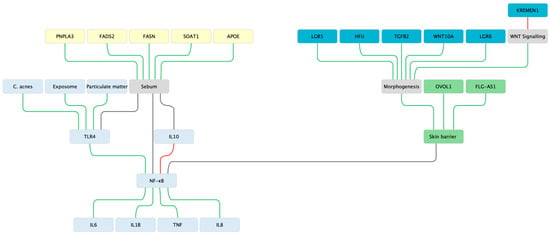
Figure 1
Open AccessReview
Fatty Amines in Detergents and Cosmetics: Current State and Biocircular Perspectives
by
Maria-Beatrice Coltelli, Annabel Serpico, Rosa Domenech, Mar Tronch, Carolina Galli, Paolo Sonzini, Clara Escrivà-Cerdán, Sergio Mastroianni, Andrea Lazzeri, Domenico Licursi and Anna Maria Raspolli Galletti
Cosmetics 2025, 12(5), 227; https://doi.org/10.3390/cosmetics12050227 - 15 Oct 2025
Abstract
Fatty amines are nitrogen-containing organic compounds synthesized from fatty acids, olefins, or alcohols, typically derived from natural oils or petrochemical sources. These molecules generally feature long hydrophobic alkyl chains ranging from C8 to C22 and can be positively charged on the nitrogen atom,
[...] Read more.
Fatty amines are nitrogen-containing organic compounds synthesized from fatty acids, olefins, or alcohols, typically derived from natural oils or petrochemical sources. These molecules generally feature long hydrophobic alkyl chains ranging from C8 to C22 and can be positively charged on the nitrogen atom, which confer pronounced cationic surface activity. This property makes them highly effective as emulsifiers, conditioning agents, antistatic agents, and surfactants, particularly in industrial formulations and personal care products such as shampoos, conditioners, and creams. Historically, the production of fatty amines has relied heavily on petrochemical feedstocks, contributing significantly to greenhouse gas emissions, particularly CO2. In response to growing environmental concerns, there is an increasing shift toward renewable and sustainable raw materials, aligning with the principles of the circular economy. The cosmetics and detergent industries are at the forefront of this transition, actively integrating bio-based ingredients to minimize ecological impact. This review provides a comprehensive overview of the sources, synthetic pathways, and applications of fatty amines. It highlights their functional roles in detergents and cosmetic formulations and explores scientific and technological strategies aimed at enhancing sustainability across the fatty amine supply chain.
Full article
(This article belongs to the Special Issue Advanced Cosmetic Sciences: Sustainability in Materials and Processes)
►▼
Show Figures
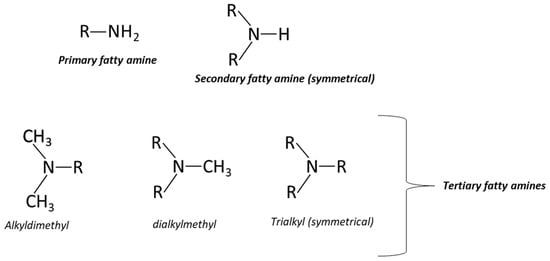
Figure 1
Open AccessArticle
Enhanced Bioavailability and Stability of Curcumin in Cosmeceuticals: Exploiting Droplet Microfluidics for Nanoemulsion Development
by
Nikolaos D. Bikiaris, Afroditi Kapourani, Ioannis Pantazos and Panagiotis Barmpalexis
Cosmetics 2025, 12(5), 226; https://doi.org/10.3390/cosmetics12050226 - 15 Oct 2025
Abstract
Curcumin (Cur), a natural polyphenolic compound with potent antioxidant and anti-inflammatory properties, faces significant challenges in cosmeceutical applications due to its poor aqueous solubility and low bioavailability. Nanotechnology offers a promising approach to overcome these limitations and enhance the functionality of cosmetic formulations.
[...] Read more.
Curcumin (Cur), a natural polyphenolic compound with potent antioxidant and anti-inflammatory properties, faces significant challenges in cosmeceutical applications due to its poor aqueous solubility and low bioavailability. Nanotechnology offers a promising approach to overcome these limitations and enhance the functionality of cosmetic formulations. In this work, Cur-loaded nanoemulsions (NEs) were developed using a droplet microfluidics technique to enhance Cur’s stability, bioavailability, and permeability for advanced cosmeceuticals. Various oils were screened for Cur solubility, with coconut oil demonstrating the highest capacity. Optimal oil-to-water flow ratios were determined to produce monodisperse NEs with controlled droplet sizes. Characterization via dynamic light scattering (DLS) revealed stable NEs with Z-potential values exceeding −30 mV at both room temperature and +4 °C for up to 21 days, indicating strong colloidal stability. Antioxidant activity was evaluated through DPPH assays, while in vitro permeability studies of the drug-loaded NEs after incorporation into suitable hydrogels, using Strat-M® membranes mimicking human skin, demonstrated significantly enhanced penetration of the encapsulated Cur. In sum, this work highlights the potential of droplet microfluidics as a scalable and precise method for producing high-performance Cur NEs tailored for cosmeceutical applications.
Full article
(This article belongs to the Section Cosmetic Formulations)
►▼
Show Figures

Figure 1
Open AccessReview
Valorization of Date Seed Waste for Sustainable Dermocosmetic Sunscreens: Phytochemical Insights and Formulation Advances
by
Nassima Siroukane, Abdelhakim Kheniche and Lynda Souiki
Cosmetics 2025, 12(5), 225; https://doi.org/10.3390/cosmetics12050225 - 15 Oct 2025
Abstract
Valorization of Phoenix dactylifera L. (date) seeds, an abundant agro-industrial byproduct, offer a sustainable approach to developing multifunctional ingredients for dermocosmetic photoprotection. Rich in polyphenols, flavonoids, and lipophilic antioxidants, date seed extracts and oils demonstrate promising UV-absorbing, anti-inflammatory, and free-radical-scavenging properties. Recent in
[...] Read more.
Valorization of Phoenix dactylifera L. (date) seeds, an abundant agro-industrial byproduct, offer a sustainable approach to developing multifunctional ingredients for dermocosmetic photoprotection. Rich in polyphenols, flavonoids, and lipophilic antioxidants, date seed extracts and oils demonstrate promising UV-absorbing, anti-inflammatory, and free-radical-scavenging properties. Recent in vitro, ex vivo, and preclinical studies underscore their potential as bioactive agents in sunscreen formulations, supporting both skin barrier integrity and oxidative stress mitigation, although clinical validation is still required. This review consolidates current knowledge on the phytochemical profile and biological efficacy of date seed derivatives, with emphasis on their integration into advanced delivery systems such as nanocarriers, Pickering emulsions, and cyclodextrin complexes to enhance photostability, skin permeability, and esthetic acceptability. Safety aspects, including allergenicity, phototoxicity, and regulatory gaps, are critically examined alongside environmental and ethical advantages, including biodegradability and vegan suitability. The findings advocate for the inclusion of Phoenix dactylifera L. seed actives in next-generation dermocosmetic sunscreens that align with circular bioeconomy principles, consumer demand for “reef-safe” products, and evolving international regulations. Further clinical validation is encouraged to fully translate these botanically derived agents into effective and ethically sound sun care innovations.
Full article
(This article belongs to the Special Issue Advanced Cosmetic Sciences: Sustainability in Materials and Processes)
►▼
Show Figures

Figure 1
Open AccessArticle
Jellybush Honey Extract: A Solution for Enhanced Wound Healing and Scar Reduction Across Diverse Skin Phototypes
by
Julie Leignadier, Marty Shortt, Florence Turgeon, Philippe Daigle and Joan Attia
Cosmetics 2025, 12(5), 224; https://doi.org/10.3390/cosmetics12050224 - 14 Oct 2025
Abstract
Wound healing dysregulation often results in visible scarring with significant psychological impact, particularly affecting individuals with darker skin phototypes. This study investigates the efficacy of an aqueous extract of Australian Jellybush honey (Leptospermum polygalifolium) in improving scar appearance across diverse skin
[...] Read more.
Wound healing dysregulation often results in visible scarring with significant psychological impact, particularly affecting individuals with darker skin phototypes. This study investigates the efficacy of an aqueous extract of Australian Jellybush honey (Leptospermum polygalifolium) in improving scar appearance across diverse skin tones. Our research demonstrated the extract reduced IL-8 production by 42%, decreased reactive oxygen species by 14.6%, and increased pro-collagen I synthesis by 28%. Ex vivo experiments revealed a 44% increase in neo-epidermal tongue length after 10 days while gene expression analysis showed coordinated wound healing through timed modulation of key markers such as filaggrin, matrix metalloproteases, keratins. In a double-blind clinical study involving 21 volunteers (phototypes II–VI) with acne scars, 8-week application of 2% Jellybush honey extract improved skin homogeneity by 15%, reduced scar surface area by 3% and decreased atrophic and hypertrophic scars dimensions by 9% and 16%, respectively, versus placebo. These improvements were consistent across all phototypes, including V-VI. Jellybush honey extract offers a promising approach for scar management through balanced modulation of wound healing pathways across all skin phototypes.
Full article
(This article belongs to the Section Cosmetic Dermatology)
►▼
Show Figures
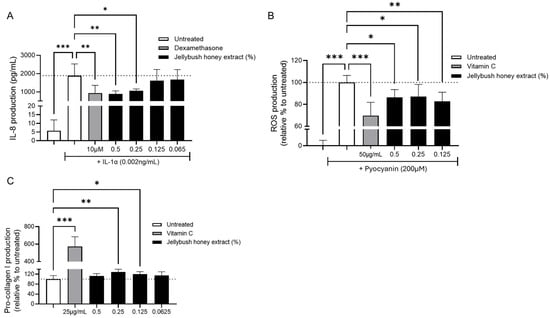
Figure 1
Open AccessArticle
Anti-Aging Efficacy of a Multi-Peptides–Silybin Complex: Mechanistic Insights and a 56-Day Clinical Evaluation
by
Hong Zhang, Huiping Hu, Chenlan Xu, Lina Wang, Ying Ye, Jiefang Huang, Yuyan Chen, Feng Liao, Yanan Li and Peiwen Sun
Cosmetics 2025, 12(5), 223; https://doi.org/10.3390/cosmetics12050223 - 10 Oct 2025
Abstract
Peptides are widely used in cosmetic formulations to stimulate extracellular matrix (ECM) synthesis, while silybin (a flavonolignan from Silybum marianum) offers retinol-like benefits through antioxidant and photoprotective activity. This study evaluated a novel anti-aging cream combining seven bioactive peptides with silybin to
[...] Read more.
Peptides are widely used in cosmetic formulations to stimulate extracellular matrix (ECM) synthesis, while silybin (a flavonolignan from Silybum marianum) offers retinol-like benefits through antioxidant and photoprotective activity. This study evaluated a novel anti-aging cream combining seven bioactive peptides with silybin to assess synergistic effects on ECM regeneration and clinical skin rejuvenation. In vitro assays in human dermal fibroblasts and keratinocytes revealed that the formulation rapidly upregulated gene and protein expression of collagen types I, III, IV, and XVII and lysyl oxidase (LOX) within 4–16 h. Ex-vivo, ultraviolet (UV)-damaged skin explants treated with the peptide–silybin complex showed enhanced recovery of collagen, elastic fibers, and LOX versus untreated controls. A 56-day clinical study (n = 31) demonstrated significant improvements in wrinkle area and volume, elasticity (+12.5%), firmness (+20.7%), and dermal density (+78%, all p < 0.001). No adverse effects were reported, and over 80% of participants noted improved skin texture and firmness. These findings highlight a novel synergy between peptides and silybin, with rapid ECM activation and clinical efficacy. To our knowledge, this is the first evidence of a cosmetic peptide formulation significantly upregulating LOX expression, suggesting a new mechanism for strengthening dermal architecture and improving skin resilience. Future studies should elucidate the mechanisms underlying these effects and assess whether other botanicals confer complementary benefits when combined with peptide blends.
Full article
(This article belongs to the Section Cosmetic Dermatology)
►▼
Show Figures

Figure 1
Open AccessArticle
Evaluation of Effectiveness, Duration and Anti-Aging Properties of Sofiderm® Hyaluronic Acid Filler: An Analysis Based on VisiaCR5 Data
by
Giordano Vespasiani, Simone Michelini, Federica Trovato, Laura Nesticò, Giuseppina Ricci, Stefania Guida and Giovanni Pellacani
Cosmetics 2025, 12(5), 222; https://doi.org/10.3390/cosmetics12050222 - 10 Oct 2025
Abstract
Hyaluronic acid (HA) fillers and botulinum toxin remain among the most frequently requested non-surgical esthetic procedures, due to their favorable safety profile and ability to restore volume and improve skin quality. However, variability in product performance and the lack of objective measurement tools
[...] Read more.
Hyaluronic acid (HA) fillers and botulinum toxin remain among the most frequently requested non-surgical esthetic procedures, due to their favorable safety profile and ability to restore volume and improve skin quality. However, variability in product performance and the lack of objective measurement tools remain challenges in clinical practice. This prospective, single-arm, non-randomized pilot study aimed to assess the esthetic efficacy, tolerability, and duration of effect of Sofiderm® HA fillers in Caucasian patients with signs of facial aging, and to explore the correlation between subjective visual grading and instrumental imaging outcomes. Five patients with Griffiths photoaging scores ranging from 4 to 8 were treated with different Sofiderm® formulations. Standardized evaluations were performed at baseline, 2 months, and 9 months using VISIA-CR and PRIMOS 3D optical profilometry. All subjects experienced measurable improvements, with an average 2-point reduction in Griffiths scores at 2 months, maintained at 9 months in most cases. Objective imaging data confirmed enhancements in volume, texture, and surface regularity. No serious adverse events occurred. These findings suggest that Sofiderm® fillers may offer sustained esthetic benefits with a favorable safety profile and demonstrate how integrated digital imaging can enhance treatment evaluation in esthetic dermatology.
Full article
(This article belongs to the Section Cosmetic Dermatology)
►▼
Show Figures

Figure 1
Open AccessReview
Cosmetic Considerations of Semaglutide
by
Alaina Baggett, Carissa Saadi, Robert Saadi and Vijay Patel
Cosmetics 2025, 12(5), 221; https://doi.org/10.3390/cosmetics12050221 - 9 Oct 2025
Abstract
Semaglutide-induced facial changes, or “Ozempic face” popularized by media, have gained increasing recognition since the widespread and growing use of Ozempic (semaglutide) for weight loss. It refers to facial volume depletion and soft tissue laxity following rapid weight loss associated with this medication.
[...] Read more.
Semaglutide-induced facial changes, or “Ozempic face” popularized by media, have gained increasing recognition since the widespread and growing use of Ozempic (semaglutide) for weight loss. It refers to facial volume depletion and soft tissue laxity following rapid weight loss associated with this medication. Semaglutide use can also cause gastrointestinal side effects, volume loss, and decrease skin quality not only in the face but globally. As the use of Ozempic becomes increasingly popular, more patients are presenting to cosmetic clinics for these undesirable esthetic changes. While cosmetic changes following rapid weight loss is not new, such as those following bariatric interventions, the accessibility and ease of GLP-1, Glucose-like protein-1, makes this a growing concern among the community. It is important for clinicians to recognize these potential effects, counsel patients appropriately, and give options for treatment. This emerging esthetic concern highlights the need for further investigation into underlying causes, risk factors, and potential interventions.
Full article
(This article belongs to the Special Issue Feature Papers in Cosmetics in 2025)
►▼
Show Figures

Figure 1
Open AccessArticle
The Effectiveness of Micro-Needle Mesotherapy with Seboregulatory Ampoule in the Treatment of Oily Skin
by
Agnieszka Ciozda, Ewelina Firlej and Joanna Bartosińska
Cosmetics 2025, 12(5), 220; https://doi.org/10.3390/cosmetics12050220 - 8 Oct 2025
Abstract
Background: Contemporary dermatology and cosmetology continue to explore effective strategies for normalizing the function of oily skin, where excessive sebum production and impairment of the hydrolipid barrier pose considerable therapeutic challenges. The aim of the present study was to evaluate the effects
[...] Read more.
Background: Contemporary dermatology and cosmetology continue to explore effective strategies for normalizing the function of oily skin, where excessive sebum production and impairment of the hydrolipid barrier pose considerable therapeutic challenges. The aim of the present study was to evaluate the effects of a series of microneedling mesotherapy treatments with a sebum-regulating ampoule on selected biophysical parameters of the skin in individuals with oily skin. Methods: The study included 19 female volunteers aged 18–42 years, who underwent six treatment sessions at three-week intervals. Skin parameters were assessed at baseline, after three sessions, and after six sessions using the MPA system (Courage & Khazaka) equipped with the following probes: Corneometer (hydration), Sebumeter (sebum secretion), pH meter (surface pH), Glossymeter (skin shininess), and Tewameter (transepidermal water loss). Results: After six sessions, hydration significantly increased both in the T-zone (from 43.9 ± 8.0 to 54.0 ± 5.4 AU; +23%) and on the cheeks (from 35.9 ± 8.3 to 55.6 ± 4.8 AU; +55%) (p < 0.001). Sebum secretion decreased markedly, with values in the T-zone falling from 192.2 ± 30.6 to 127.7 ± 27.2 AU (−34%) and on the cheeks from 185.0 ± 36.2 to 114.8 ± 30.1 AU (−38%) (p < 0.001). Skin surface pH showed minor but significant modulation within the physiological range (T-zone: 6.33 ± 0.64 → 6.01 ± 0.17; cheeks: 6.14 ± 0.50 → 6.03 ± 0.17; p = 0.021). TEWL demonstrated a nonsignificant change (T-zone: 17.46 ± 11.31 → 19.09 ± 3.54 g/m2/h; cheeks: 20.89 ± 5.36 → 18.37 ± 2.95 g/m2/h; p > 0.05), while skin gloss remained stable (T-zone: 5.46 ± 1.25 → 5.60 ± 1.16 GU; cheeks: 5.29 ± 1.76 → 4.87 ± 1.20 GU; p > 0.05). Conclusions: Microneedling mesotherapy combined with a sebum-regulating ampoule significantly improved skin hydration and reduced sebum secretion, accompanied by stabilization of skin surface pH. Although changes in TEWL and gloss were not statistically significant, the overall results indicate improved skin condition and balance. Despite the absence of a control group, these findings support the potential of this combined approach as an adjunctive therapy for oily skin. Further controlled studies with larger cohorts are warranted to confirm its efficacy and long-term effects.
Full article
(This article belongs to the Special Issue Feature Papers in Cosmetics in 2025)
►▼
Show Figures

Figure 1
Highly Accessed Articles
Latest Books
E-Mail Alert
News
Topics
Topic in
Clinics and Practice, Cosmetics, JCM, Medicina, Dermato, LabMed, Psychology International
Advances in Psychodermatology
Topic Editors: Jacek C. Szepietowski, Andrzej JaworekDeadline: 30 November 2025
Topic in
Antioxidants, Biomedicines, IJMS, Life, Oxygen, Cosmetics, Nutraceuticals
Oxidative Stress and Inflammation, 3rd Edition
Topic Editors: Maria Letizia Manca, Amparo Nacher, Matteo Perra, Ines Castangia, Mohamad AllawDeadline: 31 July 2026

Conferences
Special Issues
Special Issue in
Cosmetics
Next-Generation Molecules and Smart Delivery Systems for Skin Health and Wellness
Guest Editors: Ritamaria Di Lorenzo, Teresa SilvestriDeadline: 31 October 2025
Special Issue in
Cosmetics
Skin Care and Innovation from the Perspective of Molecular Dermatology
Guest Editors: Ewa Markiewicz, Olusola Idowu, Jacek SzepietowskiDeadline: 31 October 2025
Special Issue in
Cosmetics
Innovations in Cosmetology: Bridging Scientific Evidence and Clinical Practice
Guest Editor: Josipa BukićDeadline: 20 November 2025
Special Issue in
Cosmetics
Fine Chemicals from Natural Sources with Potential Application in the Cosmetic/Pharmaceutical Industry—Volume 2
Guest Editors: Agnieszka Feliczak-Guzik, Agata WawrzyńczakDeadline: 20 December 2025
Topical Collections
Topical Collection in
Cosmetics
Editorial Board Members' Collection Series: "Sustainability in Materials and Processes in Cosmetic Science"
Collection Editors: Pierfrancesco Morganti, Alina Sionkowska
Topical Collection in
Cosmetics
Editorial Board Members' Collection Series: "Novel Delivery Systems for Dermocosmetic Applications"
Collection Editors: Elisabetta Esposito, Debora Santonocito


